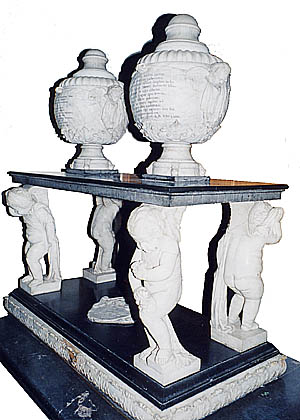
RBH Home
Maps & Travels
Articles
Legends
Towns & Villages
Castles & Houses
Churches
Biographies
Gentry
Family History
Odds & Ends
Mail David
 Sonning Church
Sonning ChurchMonument to Sir Thomas Rich
Under
Tower: Marble Table Monument
with Urns and Cherubs
This
extraordinary late 17th century monument is to Sir Thomas Rich, Bart. It
is probably of Italian workmanship, of black and white marble, and must
have cost an immense sum of money. The pavement, on which it stands, is of
marble and it is raised on black marble steps. The monument itself
consists of four colossal naked cherubs or cupids, shedding tears, and
supporting, on their wings, a vast black marble slab on which stand two
large white marble urns. The inscription, in Latin, is on the urns and is
an extravagant panegyric on the charities of Sir Thomas Rich. Lysons in
his Magna Britannia may well say, "the monument to Sir T. Rich is
very heavy." It originally stood in the South-Eastern
'Rich
Chapel' where the organ now stands, but was removed to the space under the
tower in 1852.
Sir Thomas died in 1667, aged 66 years. He was born in Gloucester and educated in London, was the son of Thomas Rich, alderman of the former city, by his wife Anne, daughter of Thomas Machin of Gloucester. He married, firstly, Barbara, daughter of Gilbert Morewood of Seale in Leicestershire, by whom he had issue: Gilbert, who died young. He married, secondly, Elizabeth, daughter of William Cockayne, alderman and merchant of London, by whom he had issue, Thomas (d.1663, aged 15), both of whom are also commemorated here. Other children included Charles and Elizabeth, who both died young; Mary, who married Sir Robert Geare, Kt of Stocke in Buckinghamshire; and William who succeeded him as 2nd Baronet and d.1711, aged 57. Sir Thomas was a Turkey merchant and during the Civil War provided the King with money and helped the suffering clergy. At the Restoration, he was created a Baronet. Sir Thomas acquired the manor of Sonning or "Holme Park" in 1654 from Laurence Halstead and Thomas Chamberlain. He was a great benefactor to the parish and enlarged the Blue Coat School at Reading, providing that there should be always three boys from Sonning educated in it. The manor was held by the family until 1795 when it was sold to Richard Palmer of Hurst.
